For the players of Major League Baseball, the World Series is the ultimate goal. For directors of MLB games on television, it's a career-crowning achievement. For two decades, two directors have been a perennial postseason dynasty. FOX's Bill Webb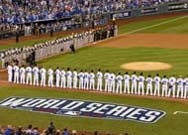
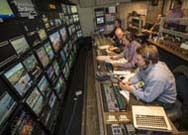 calls the shots for viewers in the United States and most of Canada, while the rest of the world watching on MLB International sees the work of John Moore. Both are regular-season stalwarts, with Webb directing Mets telecasts and FOX's MLB Game of the Week, while Moore helms Yankee games for the YES Network. But just as the athletes must rise to baseball's biggest occasion, the directors, too, must up their game. Here, two world-class directors share their creative and technical insights as they reveal what it takes to make championship TV:
calls the shots for viewers in the United States and most of Canada, while the rest of the world watching on MLB International sees the work of John Moore. Both are regular-season stalwarts, with Webb directing Mets telecasts and FOX's MLB Game of the Week, while Moore helms Yankee games for the YES Network. But just as the athletes must rise to baseball's biggest occasion, the directors, too, must up their game. Here, two world-class directors share their creative and technical insights as they reveal what it takes to make championship TV:
![]()
"Welcome baseball fans around the world and all the ships at sea."
- Gary Thorne, MLB International sportscaster
The Pregame
"Baseball switches from a very relaxed sport in July to one in October where every pitch is crucial," says Moore. When it comes to shooting the World Series, with so much tension in the air, the very atmosphere is different. "It's the biggest series of games in baseball," says Webb. "The intensity of what the players are going through matches the intensity for us because you can't miss anything. That's the biggest threat."
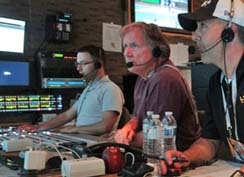 Preparation defines the pro, and it begins with crewing the show. "We travel approximately ten crew people and we'll fill in the gaps with camera, tape, audio and video people among them," says Moore. While FOX has its regular crew, Moore has more of a challenge. "This time of year it's very hard to find people that are available on a possible basis. You don't know as the playoffs unfold where the next round is going to be or how many games they'll go." For the game itself, experience "comes from doing the regular season, year after year." After preparation, concentration is key. Says Webb: "When you let down your guard, something's gonna happen. It always does so you have to stay very focused." That means keeping the audience as well as the action in mind. "Everybody thinks it's baseball," says Webb, "but it's not just sport, it's entertainment."
Preparation defines the pro, and it begins with crewing the show. "We travel approximately ten crew people and we'll fill in the gaps with camera, tape, audio and video people among them," says Moore. While FOX has its regular crew, Moore has more of a challenge. "This time of year it's very hard to find people that are available on a possible basis. You don't know as the playoffs unfold where the next round is going to be or how many games they'll go." For the game itself, experience "comes from doing the regular season, year after year." After preparation, concentration is key. Says Webb: "When you let down your guard, something's gonna happen. It always does so you have to stay very focused." That means keeping the audience as well as the action in mind. "Everybody thinks it's baseball," says Webb, "but it's not just sport, it's entertainment."
The Fans
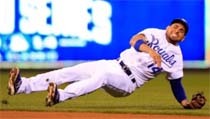 For extreme emotions during the regular season, fans wait for the rare no-hitter or walk-off home run. But during the World Series, the opportunities for suspense and exaltation multiply exponentially, condensing a Big Bang of potentially explosive plays into each game. Consequently, Moore changes how he approaches a shot sequence. "I'll tend to focus on what happened both leading up to and right after a moment, as opposed to the technicality of the play. During the regular season, there's a lot of breaking down someone's stance or release point. In October, I'll focus on the storyline of the game because that's where the emotion is." To do that, Moore utilizes more close-ups and stays with the players to capture their reactions, rather than cutting to replays.
For extreme emotions during the regular season, fans wait for the rare no-hitter or walk-off home run. But during the World Series, the opportunities for suspense and exaltation multiply exponentially, condensing a Big Bang of potentially explosive plays into each game. Consequently, Moore changes how he approaches a shot sequence. "I'll tend to focus on what happened both leading up to and right after a moment, as opposed to the technicality of the play. During the regular season, there's a lot of breaking down someone's stance or release point. In October, I'll focus on the storyline of the game because that's where the emotion is." To do that, Moore utilizes more close-ups and stays with the players to capture their reactions, rather than cutting to replays.
Culling shots from the crowd gives TV viewers a communal connection. "If the crowd's going crazy, you have to show it because it builds the drama," says Webb. "I could stay on camera four in center field and just cut between the pitcher/batter and the pitch, but that's no fun for people watching at home. So if it's a tight game, you'll show the emotion of what's going on in the stands. If it's a blow-out, all that goes out the window because people are just sitting on their hands." Either way, it's all dictated by the game. "If I do cut away, I try to get back just before the pitcher gets in his set position so you can mentally adjust to where I am now."
goes out the window because people are just sitting on their hands." Either way, it's all dictated by the game. "If I do cut away, I try to get back just before the pitcher gets in his set position so you can mentally adjust to where I am now."
Moore favors "wide shots that show perspective, or close-ups of a fan where they themselves are telling a story" such as in this 2013 World Series example: "In Game 6, the Red Sox were easily ahead and Mike Napoli struck out, and this fan reacted like the World Series was just lost. He was so devastated, he buried his head in his hands. Our announcers couldn't stop laughing. We could have showed replays, but that's technical and this time's about emotion so, after the live strike out, we showed the moments leading up to it with the crowd going crazy, then the strike out, and then this guy's deflation." Whether conveying comic relief or high drama, how directors string shots together shapes the TV viewer's experience. "It works if you're judicious, don't overdo it, and find the right people," cautions Moore. "It's got to be somebody who's giving a lot of themselves as a fan."
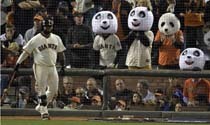 Just like individuals, each team's combined fans have a collective personality. "I compare the Giants fans to Yankees fans. They expect to win every year, so I think there was a more laissez-faire attitude in certain parts of the game, whereas the Royals fans were living and dying with every pitch." Webb sensed the same distinction: "I'm in the TV truck and you can just feel the energy that the fans give off." But whether it's the energy of entitlement or desperation, Webb tries to ensure the small screen conveys "the unique love of fans for each team in their city."
Just like individuals, each team's combined fans have a collective personality. "I compare the Giants fans to Yankees fans. They expect to win every year, so I think there was a more laissez-faire attitude in certain parts of the game, whereas the Royals fans were living and dying with every pitch." Webb sensed the same distinction: "I'm in the TV truck and you can just feel the energy that the fans give off." But whether it's the energy of entitlement or desperation, Webb tries to ensure the small screen conveys "the unique love of fans for each team in their city."
The Ballparks
If the play's the thing, the stage is the stadium. Setting that stage is the establishing shot and Webb has the toys it takes to get it: "We had a blimp in San Francisco, a fixed-wing plane in Kansas City and last year in Fenway, I had a helicopter. ENG (Electronic News Gather) shoots all the stuff outside the stadium which we use for roll-outs to commercials." Inside the stadium, each park has its own ambiance. With McCovey Cove and its animated walls, the Giants' AT&T Park is a director's dream. "Honestly, you can't help but get great pictures there because that's how pretty the place is," says Webb. Moore enjoyed showcasing the Royals' home as well: "Even though Kaufman Stadium is actually 40 years old, it's immaculate. The high first and home plate positions are a little too high, but it's still a nice place to shoot."
the stadium, each park has its own ambiance. With McCovey Cove and its animated walls, the Giants' AT&T Park is a director's dream. "Honestly, you can't help but get great pictures there because that's how pretty the place is," says Webb. Moore enjoyed showcasing the Royals' home as well: "Even though Kaufman Stadium is actually 40 years old, it's immaculate. The high first and home plate positions are a little too high, but it's still a nice place to shoot."
It can be especially challenging when new technologies and old ballparks collide, as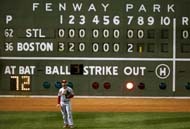 they did in Boston last year. "Fenway was a lot more difficult because you have so much blockage," recalls Webb. "The dugouts are so small that you can't see anybody on the bench if guys stand at the rail." The configuration of a stadium can force directors to adjust to pitchers, just as pitchers adjust to hitters: "A lot of times the third base coach blocks my low camera shot of the pitcher so I have to use high third if he's a righty, high first if he's a lefty." In St Louis, cameras could be placed on the home-plate side of the dugout, making Webb's life easier. "It's a brand new stadium so you can telecast the way you want to, not the way you have to."
they did in Boston last year. "Fenway was a lot more difficult because you have so much blockage," recalls Webb. "The dugouts are so small that you can't see anybody on the bench if guys stand at the rail." The configuration of a stadium can force directors to adjust to pitchers, just as pitchers adjust to hitters: "A lot of times the third base coach blocks my low camera shot of the pitcher so I have to use high third if he's a righty, high first if he's a lefty." In St Louis, cameras could be placed on the home-plate side of the dugout, making Webb's life easier. "It's a brand new stadium so you can telecast the way you want to, not the way you have to."
For Moore, finding gems in the adjustments is part of the fun. "I love shooting at Fenway Park. It makes you feel like you're a part of history. But if you're not the primary feed there, you're position starts to deteriorate rapidly." Moore's solution is 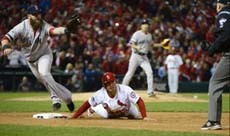 an open mind. "I always try to adapt to the different ballparks, instead of trying to force everything to be the way I usually do it." That enables Moore to create images that emanate organically from the setting. "Normally the low first camera is even with first base, but in Fenway it's way down the line. But that gives you a very unique, old-time look of a pick-off by a pitcher of a runner at first base." That play ended Game 4 in St Louis, a first in a World Series, illustrating Moore's mantra: "Let the pictures tell the story."
an open mind. "I always try to adapt to the different ballparks, instead of trying to force everything to be the way I usually do it." That enables Moore to create images that emanate organically from the setting. "Normally the low first camera is even with first base, but in Fenway it's way down the line. But that gives you a very unique, old-time look of a pick-off by a pitcher of a runner at first base." That play ended Game 4 in St Louis, a first in a World Series, illustrating Moore's mantra: "Let the pictures tell the story."
The Cameras
"I may put something on the air for 30 seconds, but I'm looking at what I'm doing next, so sometimes shots are used and I don't even get to see them," says Webb, who juggles 32 cameras while making sure each play is covered from multiple angles. The camera positions are almost identical to those at the All-Star Game, which both Webb and Moore also direct.
Having fewer cameras doesn't lessen the number of decisions. In addition to the standard seven-to-nine cameras that Moore employs for the World Series, he also has access to the FOX feeds from "the exotic cameras," such as the super-highspeed X-Mo's for detailed looks, and their extra cameras down the baselines. "It gives me a little more leeway to play around, knowing there's a net of coverage from them under me if it's needed." It frees Moore to take artistic chances: "When Hunter Pence was up, I had our tight-center camera, which is normally framed for a pitch, stay as close as possible on his face because his eyes just kind of blow up every time he moves the bat at the plate."
X-Mo's for detailed looks, and their extra cameras down the baselines. "It gives me a little more leeway to play around, knowing there's a net of coverage from them under me if it's needed." It frees Moore to take artistic chances: "When Hunter Pence was up, I had our tight-center camera, which is normally framed for a pitch, stay as close as possible on his face because his eyes just kind of blow up every time he moves the bat at the plate."
While grabbing extra shots is an added luxury for replays, it's not one Moore likes to risk live. "We don't know how they're going to move and what they're going to get, so you just try and do your game and then supplement with something that puts icing on the cake." The exceptions are the robotic dugout cameras, as their operators work with Moore on Yankee games where they've established a visual shorthand: "If I take a shot of the manager from the high first camera, they might sneak over with their robo and get a shot of him, and I'll know they know that's who I'm looking for, so we'll take the shot knowing they're not going to whiff off it."
As the game evolves, so does the technology to cover it. "We have in-ground cameras that give different perspectives," says Webb. "Until recently, they hadn't built one that small that could go Hi-Def." One is buried at home plate where the grass meets the dirt, looking up at the batter's swing. Another, at first base, records the runner coming into the bag and the first baseman catching the ball, showing which came first. For directors, the 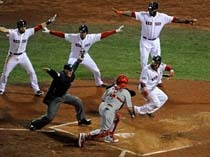 perfect sequence captures everyone at the height of activity. Webb illustrates how he calls the frenetic shots with a recapping of an exhilarating play from the 2013 World Series, in which Boston's Shane Victorino's Game 6 double scored the clinching runs:
perfect sequence captures everyone at the height of activity. Webb illustrates how he calls the frenetic shots with a recapping of an exhilarating play from the 2013 World Series, in which Boston's Shane Victorino's Game 6 double scored the clinching runs:
"I'll always say 'take' first followed by the camera's number, as in 'take two' for the hit. Then the runner coming in is 'ready five, take five' for the low first camera, then back to camera 'two' at high home for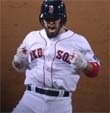 the ball, then the second runner's coming in, but I couldn't see him because guys were coming out of the dugout, so it was 'ready five - two!' Then (Jonny) Gomes slides in right behind him, and it's 'ready one, take one' for Victorino at second base - 'don't pound your chest until I get there!' - on the low third camera, and then 'take six' for high third on Gomes going to the dugout." The sequence, which consisted of six cuts, proves a Webbism: "Sometimes you get lucky and sometimes you get blocked."
the ball, then the second runner's coming in, but I couldn't see him because guys were coming out of the dugout, so it was 'ready five - two!' Then (Jonny) Gomes slides in right behind him, and it's 'ready one, take one' for Victorino at second base - 'don't pound your chest until I get there!' - on the low third camera, and then 'take six' for high third on Gomes going to the dugout." The sequence, which consisted of six cuts, proves a Webbism: "Sometimes you get lucky and sometimes you get blocked."
"Every World Series there's one or two FOX cameras that are off-limits until they've used it a year or so." says Moore. For the last three years, that camera's been the 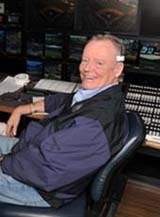 Phantom. "It was developed for ballistics velocity," explains Webb. "You've seen that shot when the bullet comes out of the muzzle of the gun? That's it. Then they incorporated it at space launches. Then they adapted it to use for baseball and we got it." While slow-motion cameras generally go from 400 to 800 frames per second, the Phantom can play back in 2000 to 5000 frames, creating arresting images in stunning detail. This year, Webb had two Phantoms to play with, adding even more vivid crayons to his already packed coloring box. "They're on low first and low third, but they're way outside the dugout because the lens is so big."
Phantom. "It was developed for ballistics velocity," explains Webb. "You've seen that shot when the bullet comes out of the muzzle of the gun? That's it. Then they incorporated it at space launches. Then they adapted it to use for baseball and we got it." While slow-motion cameras generally go from 400 to 800 frames per second, the Phantom can play back in 2000 to 5000 frames, creating arresting images in stunning detail. This year, Webb had two Phantoms to play with, adding even more vivid crayons to his already packed coloring box. "They're on low first and low third, but they're way outside the dugout because the lens is so big."
Webb marvels at the Phantom's depth of field. "Last year, we had a batter at first base that just drove in a run. You see the jubilation and, in the background, you see the pitcher walking off the mound being relieved. Almost every shot that we put on the air was so beautiful." Ironically, the Phantom's best advantage is also its biggest drawback: "The only problem is, it's so slow, you just don't have time to show a batter's whole swing because the next pitch is coming so we have to start playback halfway through." For the definitive Phantom shot, Webb goes back to 2012: "That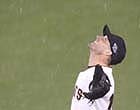 one of the second baseman (Giants' Marco Scutaro) during the NLCS when the rain was coming down and he just put his hands up like he was looking at the gods and saying 'why now?' I would never have been able to do that with a regular X-Mo, but that one's famous."
one of the second baseman (Giants' Marco Scutaro) during the NLCS when the rain was coming down and he just put his hands up like he was looking at the gods and saying 'why now?' I would never have been able to do that with a regular X-Mo, but that one's famous."
With sights breaking new ground, sound is Webb's next frontier. "We have up to 90 microphones around the stadium. What FOX has done is basically taken us out of silent movies. Now, everybody can hear the ball going into the glove at second base." But Webb wants more players to wear microphones, regardless of their unguarded language. "I'd rather have a five-second delay and hear the thoughts from the players' aspect of the game." Until then, it's up to the announcers to turn The Show into talking pictures.
 ""Truly great history is not subtle. You know at the time you're watching it, you're seeing something for the ages. And that's what we saw watching Madison Bumgarner pitch."
""Truly great history is not subtle. You know at the time you're watching it, you're seeing something for the ages. And that's what we saw watching Madison Bumgarner pitch."
- Tom Verducchi, FOX Sports sportscaster.
The Emblematic Play
When there's a memorable play in the making, everyone feels it. "It really became apparent in Kansas City in Game 7 in the bottom of the ninth when they were down one run." recalls Webb. "The fan base was going crazy." That's when the 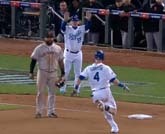 Royals' Alex Gordon hit a single-turned-triple as Giants outfielders misplayed and booted the ball. Fans still debate whether Gordon should have been sent home instead of held at third. "With the added anxiety on the throw, they might not have made a perfect relay or the catcher might have dropped the ball, so Gordon might have scored the tying run," says Moore. "Even if he ended up dead at the plate, you have to roll the dice because what are the odds you're gonna get a hit off Bumgarner when he's unhittable?" That's a question the Royals can wrestle with all winter. For Moore, "It was the most exciting play of the World Series."
Royals' Alex Gordon hit a single-turned-triple as Giants outfielders misplayed and booted the ball. Fans still debate whether Gordon should have been sent home instead of held at third. "With the added anxiety on the throw, they might not have made a perfect relay or the catcher might have dropped the ball, so Gordon might have scored the tying run," says Moore. "Even if he ended up dead at the plate, you have to roll the dice because what are the odds you're gonna get a hit off Bumgarner when he's unhittable?" That's a question the Royals can wrestle with all winter. For Moore, "It was the most exciting play of the World Series."
But defining plays aren't always thrilling. This year saw the first World Series in which an appealed play using instant replay resulted in an overturned call. Now, what the cameras capture can actually affect the game. "New York is the command center," explains Moore. "They get feeds of different cameras from all the outlets broadcasting, and they'll say which angle was used to make the determination." So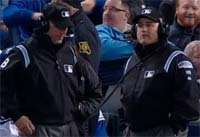 reviewing umpires can study both live and taped programming, "we'll just unload the saddle bags" says Webb, who shows the same replays to viewers so they can make up their own minds.
reviewing umpires can study both live and taped programming, "we'll just unload the saddle bags" says Webb, who shows the same replays to viewers so they can make up their own minds.
To make the interminable wait compelling, Webb called for a triple-split-screen, showing the managers on the sides with the umpires in the middle, listening on headsets for the ruling. Instead of stacking shots vertically, the way projected film runs, Webb builds action horizontally, a design befitting digital TV's widescreen aspect ratio, creating natural head-turners. "I'm watching for the umpires to take off their headsets. Then right after they called him out I cut to the runner at first base going back into the dugout." By dipping into his crayon box of replays, splits and cuts, Webb showed what was at stake, while relaying the story visually. "I just wish it wasn't such a long story," quips Webb, who proudly learned the deciding camera angle was a low first replay. (The Phantom strikes again!)
Moore already has the distinction of being the director for the first instant replay appeal in MLB history on a 2008 Alex Rodriguez home run. (It was upheld.) But in baseball, there's a first time for everything, as the 2013 World Series proved. The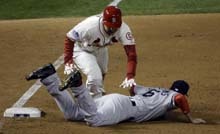 most emblematic of its many bizarre plays ended Game 3 when the Cardinals' Allen Craig tripped over the Red Sox's third baseman, Will Middlebrooks, to stumble home. When obstruction was called on Middlebrooks for raising his legs while sprawled on the ground, Craig became the winning run. "I've never seen anything like that," says Webb. Yet he covered it by the book: "The same iso-patterns that were pre-set 15 years ago still work. You just gotta stay with the ball and runners live, and everything else is gonna be isolated by the crew so you know it's gonna be there."
most emblematic of its many bizarre plays ended Game 3 when the Cardinals' Allen Craig tripped over the Red Sox's third baseman, Will Middlebrooks, to stumble home. When obstruction was called on Middlebrooks for raising his legs while sprawled on the ground, Craig became the winning run. "I've never seen anything like that," says Webb. Yet he covered it by the book: "The same iso-patterns that were pre-set 15 years ago still work. You just gotta stay with the ball and runners live, and everything else is gonna be isolated by the crew so you know it's gonna be there."
"Once the World Series gets to six games, it's always fun," says Moore. "Last year's might not have been well-played, but it certainly took on its own character. It capitalized on what those of us who love baseball, love about it: the things that you never could predict would happen in a game, happen so often, and it's something unique every time, but it's never the same unique thing."
The Clinch
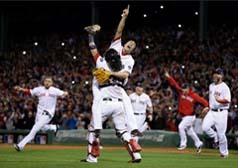 "I have a sheet of about 20 different shots for different cameras so, as the last batter is coming to the plate, all the camera guys are isolating individual players," says Webb. "When the game is over, we do a tape-roll of their reactions, both dugouts and the celebration on the field." Within the pileup, Webb has two handheld cameras seeking iconic images of victory. In the 2013 Series, "I had cameras isolated on the pitcher and catcher, but the live shot was blocked by all the Red Sox players coming out of the dugout, so I stayed on camera four in center field and just pushed in on them." The move helped heighten the moment as catcher David Ross hoisted reliever Koji Uehara up and spun him around while Uehara raised a "we're number one" finger to the sky. The clinching "Webb-gem" will grace the Fox Sports logo for a year.
"I have a sheet of about 20 different shots for different cameras so, as the last batter is coming to the plate, all the camera guys are isolating individual players," says Webb. "When the game is over, we do a tape-roll of their reactions, both dugouts and the celebration on the field." Within the pileup, Webb has two handheld cameras seeking iconic images of victory. In the 2013 Series, "I had cameras isolated on the pitcher and catcher, but the live shot was blocked by all the Red Sox players coming out of the dugout, so I stayed on camera four in center field and just pushed in on them." The move helped heighten the moment as catcher David Ross hoisted reliever Koji Uehara up and spun him around while Uehara raised a "we're number one" finger to the sky. The clinching "Webb-gem" will grace the Fox Sports logo for a year.
 But not all pitchers emote commercials. Moore marvels at Bumgarner's stoic demeanor as much as his mastery. "He was lights out in as dominating a performance as I've ever seen in a World Series, but when he won Game 5 with the shutout, he didn't react at all. You could read his lips. It was just 'nice game, way to go, babe.' It kind of showed what he's about, as in 'okay, all we did is win a game. It's not over.'" But after logging three wins and a record low 0.25 ERA, the machine that is Madison showed his humanity, giving Moore a Game 7-winning money-shot to immortalize.
But not all pitchers emote commercials. Moore marvels at Bumgarner's stoic demeanor as much as his mastery. "He was lights out in as dominating a performance as I've ever seen in a World Series, but when he won Game 5 with the shutout, he didn't react at all. You could read his lips. It was just 'nice game, way to go, babe.' It kind of showed what he's about, as in 'okay, all we did is win a game. It's not over.'" But after logging three wins and a record low 0.25 ERA, the machine that is Madison showed his humanity, giving Moore a Game 7-winning money-shot to immortalize.
After the big win, the camera crew scrambles for the clubhouse. "Right away we're prepping for the ceremony 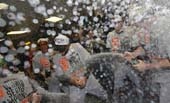 in the locker room, the trophy presentations and manager interviews," says Webb. "That's all blocked out. For the champagne shots, they wrap the handheld cameras up in special wet gear so it stays dry, but I tell my camera guys, 'save yourself.'" With the Series wrapped, just like the champions, the directors and their crews can bask until spring.
in the locker room, the trophy presentations and manager interviews," says Webb. "That's all blocked out. For the champagne shots, they wrap the handheld cameras up in special wet gear so it stays dry, but I tell my camera guys, 'save yourself.'" With the Series wrapped, just like the champions, the directors and their crews can bask until spring.
The Postgame
"For years I thought I had the flu after the World Series," says Webb. "The human body is amazing. It'll stay in tune until you get through something you have to do, and then as soon as it's over, your whole body goes into shock." Moore catches the eerily same cold: "Every year I get sick right after the World Series. It's like the body just says 'okay, you're done' and shuts down." Webb's remedy? "You take time off and try to catch up on sleep. Then all winter I'll work out, just to be in shape for the next season."
just says 'okay, you're done' and shuts down." Webb's remedy? "You take time off and try to catch up on sleep. Then all winter I'll work out, just to be in shape for the next season."
But that's only part of the recovery, as Webb insists, "the mental stress is worse than the physical stress." Moore explains: "It's spending a lot of energy with a group of people in a very condensed time, doing games that are very intense, and you walk out of it very exhausted, but you feel like you were a part of something special." With the off-season comes the chance to reflect on the unique nature of that annual accomplishment.
"With Gary's line, we always salute the people in the military who are overseas, and I always think about somebody who's sitting in a base or on a ship somewhere, and how it must bring them home, if only temporarily," reflects Moore. "It's a pretty special feeling." Webb also feels the privilege that comes with shaping baseball TV lore: "I'm very lucky to be doing it for so long. Each World Series is amazing. All the emotions involved in the game are just incredible and it gets better and better every year." It's enough to make him wax poetic: "The camera guys are my eyes, the announcers are my ears, the game is my soul." And if the game has great directors, they bring everyone home.
how it must bring them home, if only temporarily," reflects Moore. "It's a pretty special feeling." Webb also feels the privilege that comes with shaping baseball TV lore: "I'm very lucky to be doing it for so long. Each World Series is amazing. All the emotions involved in the game are just incredible and it gets better and better every year." It's enough to make him wax poetic: "The camera guys are my eyes, the announcers are my ears, the game is my soul." And if the game has great directors, they bring everyone home.
Previously in Shooting Diamonds: Directing Sandman's Exit. Up next in Shooting Diamonds: Directing the No-Hitter.
 For a an inside look at great World Series moments from the announcers who called them, go here. For another Giants World Series, go here. For another Cardinals World Series, go here. For a look at the only perfect World Series game in MLB history, go here. For more on the author, visit www.devramaza.com.
For a an inside look at great World Series moments from the announcers who called them, go here. For another Giants World Series, go here. For another Cardinals World Series, go here. For a look at the only perfect World Series game in MLB history, go here. For more on the author, visit www.devramaza.com.
Photo credits: World Series lineup, McCovey Cove, Royals fans, AT&T Park, Matt Holliday in Fenway, Gomes is safe, Uehara and Ross, Giants champagne, courtesy of AP; FOX Sports crew, Victorino, Bill Webb, Scutaro, Umpires, courtesy of FOX Sports. John Moore (center), MLBI truck, courtesy of MLB International; Omar Infante, Pence, Bumgarner's back, Gordon, Craig and Middlebrooks, Bumgarner pitches, Giants clinch, courtesy of Getty Images; Pablo Sandoval and pandas, courtesy of USA Today Sports; Mike Napoli and Kolten Wong pick off, courtesy of EPA; Scutaro rainglobe, courtesy of Rainglobes.com; World Series ball, courtesy of MLB. ![]()
Baseball Champions:What's your favorite all-time World Series TV moment? Tell us in Conversations.
